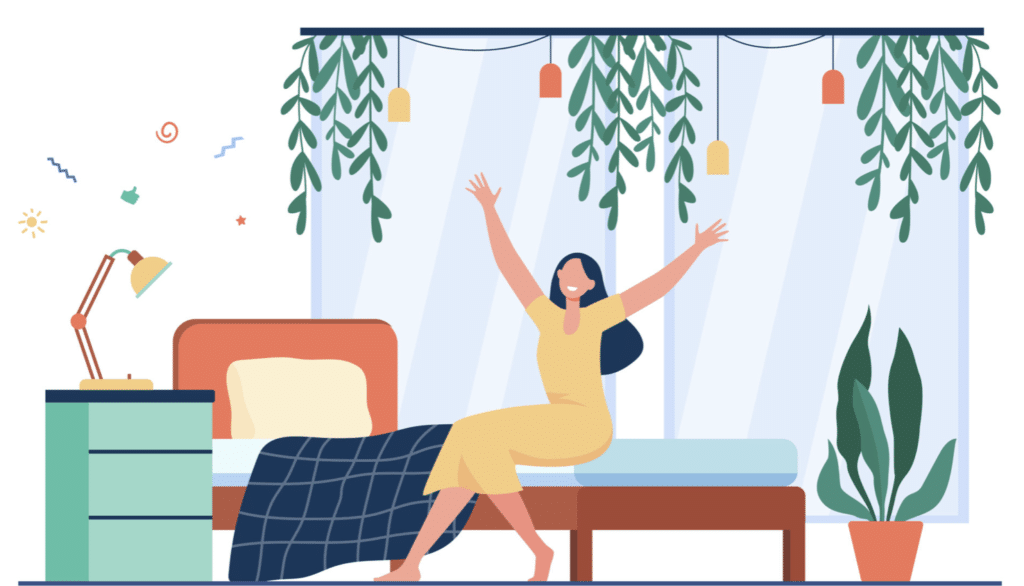
You spend about a third of your life sleeping. That’s 2920 hours a year, 240 hours a month, and 56 hours per week! With a few little tweaks and changes, you can ensure that the place you spend all of these hours also helps improve the quality and quantity of sleep you get every night. You don’t even have to spend a lot of money to build a sleep sanctuary!
Is my sleep environment really important?
A lot of variables are at play when it comes to your sleep quality but it all starts with your sleep environment. Characteristics of your bedroom can actually impair the quality of sleep you get every night. You should look at your bedroom as a sacred place for you to sleep – it needs to feel inviting, cozy, and you should feel safe in there.
THE BASICS OF A SLEEP SANCTUARY
If you just want the quick and easy fixes, here’s what to focus on:
- Declutter: Your brain sees mess as a “to-do” list that lingers above you as you sleep. A clean room is like checking off that to-do list. Have baskets and boxes around so that you can tidy up in a bind before bed when needed.
- Cozy bed: If your mattress is over 5 years, consider getting a new one. Grab yourself some cozy sheets with natural fibers like cotton or bamboo that wick away moisture. Surround yourself with cozy bedding, comfy pillows, and give your body a truly restful experience every night.
- Lighting: Change out your current lights for 40-watt bulbs to reduce the negative impact of lighting on melatonin. You can also use light dimmers to help set a “mood for sleep.” Install motion sensor night lights to help navigate nighttime bathroom breaks while avoiding the stimulating effects of bright lights. If there is light leaking in from outside, use black-out curtains or blinds and keep an eye-mask in your nightstand.
A basic sanctuary is a good start!
However, if you really want to treat yourself to an idea environment, there are many things you can do to transform your bedroom into a sleep sanctuary fit for sleeping beauty (she deserved better and we all know it)
THE NEXT-LEVEL GUIDE TO A SLEEP SANCTUARY
STEP ONE: START WITH AN EMPTY ROOM
In order to create a sleep sanctuary, we should start reeeeally basic. Imagine removing everything from your bedroom. Now you’re left with the bare necessities of a room: the walls, a window or two, and probably a thermostat. Let’s start there:
What is the color of relaxation?
Your bedroom walls may not seem like an important factor for sleep, but research has shown people sleep better when they are surrounded by a color they like. So, while keeping that in mind, it’s also important that your bedroom is calm and inviting. Here are some tips to help you narrow your choices down:
- Blue: The number one choice when creating a peaceful bedroom. Blue is commonly associated with peaceful scenes like expansive summer skies and gigantic serene oceans. Research has shown that the color blue is calming and evokes feelings of tranquility, openness, and peace.
- Green: If you find nature soothing, green is an excellent choice. Earthy green tones reminiscent of moss, pines, and grassy fields can bring about feelings of peace. Research supports green as a color that induces positive emotions like relaxation and comfort.
- Yellow: There’s nothing quite like a ray of sunshine brushing across your face to bring a sense of inner warmth. Yellow is associated with sunshine. In color-word associations, people describe yellow as warmth, cheer, and happiness. A yellow room can bring out these feelings and help you feel calm before bedtime.
- Colors to avoid: Try to avoid colors like red (associated with danger, erotic pleasure, or feeling activated), gray (associated with gloom, anxiety, and uncertainty), and purple (associated with creativity and known to be mentally stimulating).
Does paint finish matter?
The color is not the only thing to consider. Glossy (even semi-gloss and satin finish) should be avoided since they reflect light. Since you are trying to minimize the light bouncing in your room while you sleep, it’s best to stick with matte finishes that reflect zero light. Try to use a matte, eggshell, or flat finish paint that absorbs light rather than reflects it. Matte finishes also make colors more inviting and atmospheric which are words you want to hear when talking about the place you’re going to be sleeping in.
How warm is your room?
Sleeping in a warm room can be disruptive to sleep. Your circadian rhythm causes your body to cool down at night and continue cooling until the wee hours of the morning. This is to optimize melatonin and maintain quality sleep. Therefore, sleeping in a room with a cooler temperature will give you a better quality of sleep. Set your thermostat to 65℉ (18.3℃), but keep in mind that other factors can have an impact on your room’s temperature. It can take some trial and error to find what works for you but start cooler since your body needs to be cool for quality sleep. You can also use strategies like minimizing blankets and wearing moisture-wicking fabrics to help better regulate your temperature during sleep. Heck, sleep in the buff even, just stay cool.
How's your air quality?
Air quality can be a big detriment to sleep. This aspect of your bedroom is the most likely to be overlooked, even though proper ventilation has been found to improve your sleep quality. It’s important to consider outdoor and indoor air pollution, how to measure it, and what you can do to make sure pollution isn’t affecting the air quality where you lay your head at night.
In what ways can air pollution affect my sleeping quarters?
Outdoor air pollution getting inside:
The most common ways outdoor air pollution can get into your bedroom is through open windows or doors, but they can also get in through cracks in walls or window sealant.
Make sure you are testing your air quality before opening windows and checking your insulation around your windows and doors regularly!
Indoor air pollution:
When you think of air pollution, your mind might automatically go to things like smoke towers, exhaust pipe emissions, or smog, but there are actually many sources of indoor air pollution that are extremely dangerous to your health and incredibly easy to go unnoticed.
These include mold, dust mites, or gases used to cook or heat your home.
How can I test the air pollution levels in my home? You can monitor your indoor air quality (IAQ) with live air quality data available online (now, that’s helpful!) or invest in your own portable air quality monitor to measure air pollution within your home in real-time!
How can I reduce the amount of air pollution in my home?
High-performance air purifiers with HEPA filters can reduce the number of pollutants and allergens in your home by 99.5%. Alternatively, you could choose to keep plants in your bedroom as they are known to help air quality by pulling carbon dioxide from the air and filtering out harmful chemicals!
Here are some tips to ensure that you are optimizing the air quality in your bedroom:
- Open your bedroom window: Opening your window at night will increase the oxygen in your bedroom and circulate the air, while also helping to disperse any indoor air pollutants. It can provide a nice breeze, which can be relaxing and sleep-enhancing.
- Turn a fan on: Fans can circulate your bedroom air and increase ventilation. This is a great option for when the outside weather is too hot or cold to keep your window open, if you live in a noisy/busy area, or if the outdoor air pollution is at an unhealthy level.
- Get an air conditioner: Air conditioning is a great choice to increase air quality, especially in the summer months if the weather is too hot and humid to open a window.
How are your moisture levels?
Depending on the level of humidity you can expect from your location and the time of year, you might need to account for how the humidity can affect the temperature in your bedroom.
How can I determine the level of humidity in my bedroom? This is so easy to do with a humidity sensor, which (good news!) are usually very inexpensive. If you already have a digital thermostat in your bedroom, check it out, because some thermostats have humidity sensors built right in!
In what ways can humidity affect my sleeping quarters?
High humidity on sleep:
- Increases wakefulness
- Reduces the amount of time spent in REM sleep and slow-wave sleep, which can have a detrimental impact on memory consolidation and immune system response.
Excessively dry air on sleep:
- Causes dry skin and eyes, sore throat.
- Worsens snoring and sleep apnea
- Can lead to respiratory infections
What are the best humidity levels for sleep? The Environmental Protection Agency suggests the best humidity levels for sleep are 30-50% and are never to exceed 60%.
How can I adjust the humidity in my home? You might want to invest in a dehumidifier if the humidity levels in your home exceed 60% or a humidifier if you wake up with dry, itchy eyes and a sore, scratchy throat.
Now that the bare necessities of your room are ready,
let’s go put some stuff in it!
STEP TWO: THE BEDTIME BASICS
What would be the first thing you would think to put into a bedroom? You’re probably thinking “duh, a bed”, but there is so much more to think about. Mattresses, pillows, sheets, and blankets, let’s dive in and make you the best bed possible!
How's your mattress?
Picking a mattress is about as hard as picking a needle out of a haystack. We won’t give you specific mattress recommendations right now because that would take 12 years. What we do want you to know is that the most popular mattresses are similar in quality and there are many great mattresses available for affordable prices.
You should ask yourself– Is the mattress you’re sleeping on now still ok or should you upgrade? If you need to upgrade, how do you choose? Don’t worry, we have some great tips for you:
How old is your mattress? Mattresses wear down over time, you may be able to feel the springs, or the pillow top might start leaning to one side. Mattresses older than 5-7 years should be replaced so they don’t lead to pain and stiffness.
What kind of mattress is best? The kind of mattress you should use depends on the kind of sleeper you are. Research has found that most people benefit from a medium-firm mattress, although side-sleepers might benefit from a softer foam mattress. There are now many full foam mattresses available in different firmness levels that provide support for a variety of sleepers and also make it easier to sleep with a partner who tosses and turns.
Mattress pads: If a brand new mattress isn’t in the budget, consider buying a mattress pad. You can purchase memory foam pads for any bed. They are more affordable and can make a huge difference in sleep quality.
Time for pillow talk!
The right pillow is so important, not just for sleep quality, but for keeping your spine aligned while you sleep. You can buy pillows that are designed specifically for your sleeping position, pillows to wedge between your legs to reduce lower back pain, and pillows for propping you up to reduce snoring. So many pillows! So how can you figure out if the pillow you are using is helping or harming your sleep? Here’s some tips to consider:
Pillow test: This one is really easy! Take your pillow and fold it in half. Did it stay folded? If you said yes, you need a new pillow. Another effective test is to ask yourself when you bought the pillow. If you can’t remember, it’s likely time for a new pillow.
Life of a pillow: To know the life of a pillow, you have to consider the quality of the material. Memory foam pillows can last for a long period of time (5 or more years), while polyester, feathers, and synthetic fabrics break down much quicker. Replace pillows if they do not pass the “pillow test”, or if they become stained or bulky.
Tips for making pillows last longer:
1. Wash them at least once a year.
2. Wash pillowcases weekly.
3. Rotate and flip pillows regularly.
4. Avoid folding your pillow. If you need extra height, add an extra pillow instead.
Choosing the right pillow depends on your sleep position!
Depending on the position you sleep in, whether you suffer from chronic pain, or if you overheat at night, these are all reasons you may need to rethink the type of pillow you’re using. Check out our recommendations for the type of pillows that might benefit you, and keep in mind that the right pillow for you is the pillow that keeps your spine aligned while also keeping you comfortable.
SIDE SLEEPERS
You’ll want to choose a thicker pillow that’s of medium firmness to support your neck and spine while sleeping on your side.
- Body pillows: A pillow such as a Spooner Body Pillow is long, thick, and shaped like a C. They’re really great for back and belly support, and because of its shape you can have it under your head and support your body at the same time!
- Bed pillow: Tucking a pillow in between your knees will keep your spine properly aligned. If you sleep on your side and don’t have any support between your legs, your upper leg will rotate downwards and distort the natural line of your spine by pulling your pelvis down. Yikes, that sounds uncomfortable!
BACK SLEEPERS
You’re going to want a pillow that supports the natural curvature of your spine, while also supporting your head, neck, and shoulders. You should choose a firmness that feels the most comfortable and avoid a flat pillow.
- Neck roll pillow: You can replace your standard pillow with a neck roll pillow, or use it as extra support with your standard pillow. These pillows can support the natural curve of your spine and minimize nerve pressure.
- Memory foam: Memory foam pillows are excellent choices for back sleepers since they contort to your body’s natural shape.
STOMACH SLEEPERS
You’re going to want to use a very thin pillow, or maybe even no pillow at all (you can just lay your head right on the mattress)!
Sleeping on your stomach should be avoided if possible due to the amount of strain it places on your neck and upper back. However, changing from your favorite position is easier said than done.

- Adding a thin pillow under your pelvis: This extra support will keep your back aligned.
- Adjustable pillows: They let you remove excess filler to find a pillow thickness that’s custom to your needs. Choose a thickness that keeps your spine fairly neutral while you sleep.
- Down or down-alternative: Stomach sleepers tend to do a little better with softer pillows.
SUFFERING FROM NECK/BACK PAIN
The best sleep position for dealing with chronic pain, such as sciatica, is on your back.
In addition to the above suggestions for back-sleepers, here are some tips that specifically target neck and back pain:
- Knee pillows: By adding 1-2 pillows underneath your knees, you can significantly reduce backpressure during sleep that can lead to chronic pain.
- Pillow-wedge: Pillow wedges look like a big firm triangle. It might remind you of something children would play on, but it is a game-changer for sleeping with chronic pain. Using it on your lower body can increase circulation and reduce inflammation that leads to body pains.
OVERHEATING AT NIGHT
No one likes to wake up with a sweaty wet pillow at night. Sure, you could flip your pillow over to the cool, dry side, but depending on how hot and sweaty you get through the night, this won’t help you more than the one time.
Here are some suggestions to keep your head cool all night:
- Cooling pillows: These pillows can regulate your body temperature and reduce the chances of heat building up on the surface of your pillow!
- Gel pillows: A type of cooling pillow, but with added gel beads that further prevent heat retention.
What about pillowcases?
The pillowcase you choose can be just as important as the type of pillow you choose! It is what your head lays directly upon as you try to get the best sleep, so you want it to be soft and comfortable.
- Silk or Satin: Silk or satin pillowcases have a smooth and shiny surface that is gentle on your skin and great for your hair.
- Cotton: Cotton pillowcases are generally the most affordable and are moisture-wicking, meaning they’re great for all you hot-sleepers because they can absorb your sweat and let you sleep cool and dry.
- Pillowcases to avoid: If possible, avoid materials such as nylon or polyester for your pillowcase as they’re not absorbent and can intensify nightly sweating.
Let's spend some time in the sheets!
There is no better feeling in the world than climbing into fresh sheets at the end of a long day. The quality of your sheets can actually have a big impact on your quality of sleep. Your sheets should feel appealing to the touch and be moisture-wicking for temperature control. Make sure to clean your sheets on a weekly basis to keep your bed inviting. You deserve it.
Higher thread count doesn’t always mean higher quality: Thread counts above 500 often lead to changes in fibers that resemble synthetic fibers. This means that the natural qualities of the fibers get lost in production. While it may feel silky, high thread count sheets may also hold moisture and be less helpful for temperature control. In the words of Dr. Breus, “The Sleep Doctor”, Michael J. Breus, “thread counts exceeding 500 are redefining the word “thread” because, at that point, what you’re looking at is probably two textiles that are woven together.” Save your money and stick with natural fabrics.
Swap sheets: Buy new bedding every 18 to 24 months or, if you’re on a budget, simply replace pillowcases.
How to choose your sheets!
Thread counts above 500 often lead to changes in fibers that resemble synthetic fibers. This means that the natural qualities of the fibers get lost in production. While it may feel silky, high thread count sheets may also hold moisture and be less helpful for temperature control. In the words of Dr. Breus, “The Sleep Doctor”, Michael J. Breus, “thread counts exceeding 500 are redefining the word “thread” because, at that point, what you’re looking at is probably two textiles that are woven together.” Save your money and stick with natural fabrics.
- Sheets for every season: If you live somewhere with seasons you may want to have specific sheets for each season. Try a jersey sheet in winter and a lighter sheet for summer.
- What to avoid: Stay away from synthetic fabrics like polyester, which trap heat and can leave you feeling hot and sweaty at night.
- Beware of allergies: Many issues with sheets are due to allergic reactions to detergents. If you have sensitive skin or allergies always wash your bedding in detergent that’s free of dye and perfumes.
How to choose your blankets!
When you’re choosing a blanket, you want something that is going to make you comfortable and sleep better, but you also want it to create an inviting atmosphere. The right blanket can help you get high-quality sleep. There is a lot to think about when choosing the right blanket and you may want a few options available for different seasons.
Here are some tips to help you choose a blanket for you:
- Down comforter: Filled with down feathers from geese or ducks, these comforters are a great cozy choice for many people. They are known for being light, soft, and warm. If you’re allergic to down, try a down alternative.
- Weighted blanket: Research has shown that using weighted blankets can decrease anxiety and can be effective for treating insomnia. It is suggested to use a blanket with 10% of your body weight. So, if you weigh 150lbs, you should choose a weighted blanket of 15lbs.
- Cooling comforter: If you’re someone who gets hot and sweaty when you sleep, try a cooler comforter made with eucalyptus. They’re able to keep you warm while preventing overheating.
How many blankets should you use?
- Number of blankets: It has been suggested that sleeping with two blankets (one thick blanket and one thin blanket) is the perfect balance for optimal sleep. However, it will also depend on factors like your environment, age, and personal preference. If you overheat a lot at night you may just want to stick with one.
Does the color of your blankets matter?
Your comforter is going to be the first thing you see when you look at your bed, so you’re probably going to want it to look as inviting and cozy as it feels. Consider the color you chose for your bedroom walls and try to accent that color with lighter or darker shades. Patterns can be nice, but try to avoid “busy” or “eccentric” patterns that can be overly stimulating. Overall, just pick something you like.
STEP THREE: TO LIGHT OR NOT TO LIGHT
You will obviously need some sort of lighting in your bedroom, we know this. We also know that light can be incredibly intrusive on your slumber, so make sure you know what type of lights and how much light is ok before and during bedtime.
Room Lighting
Bright lighting in your room can make it open and inviting, which is great for when you’re getting ready for your day. When you’re getting ready for bed, however, exposure to bright lighting will suppress your sleep hormone, melatonin, and can mess with your sleep cycle.
- Use lamplight: Consider leaving your bedroom light off prior to bedtime and instead rely on your lamplight. Lamplight is not as bright and lights up a smaller area than an overhead light, reducing your light exposure.
- Swap your bulbs: Switch your current bulbs out for 40-watt bulbs to reduce the impact they have on your circadian rhythm in the evening.
- Consider a dimmer: Installing a dimmer switch to your bedroom light can be helpful for reducing light exposure. You can also implement dimming your bedroom light into your bedtime routine, creating a cozy ambiance before bed and inducing melatonin release.
- Cover other sources of light: LED lights are everywhere! Extension cords, alarm clocks, air conditioners, humidifiers, electronics. Make sure ambient room light is pointed away or blocked from your vision while you snooze. If it’s complicated, just go with an eye mask as these light sources can be disruptive to sleep and reduce your natural melatonin levels.
Blackout curtains
Even if you’ve done everything right in the lighting department, there is still the problem of environmental light, such as street lights. Blackout curtains block light pollution, which can be extremely helpful for shift workers who may need to sleep during the day. As an alternative, you can use a sleep mask to make sure you are eliminating all light pollution. Choose silk as it’s the nicest on your skin and some people even claim it helps prevent wrinkles.
Nightlights
Who hasn’t tried their hardest to go to the bathroom in the middle of the night without fully waking up? You probably would not be the only one to admit you’ve completed your bathroom trip without even opening your eyes. Nightlights can be very useful for those middle-of-the-night bathroom trips or if you live with small children who wake up through the night.
Choose motion sensor night lights so they don’t continue to disrupt you once you’ve returned to bed.
STEP FOUR: SCREENS AND SLEEP DON'T MIX
When you were visually removing everything from your bedroom, did you end up removing electronics like a TV or game console? Cool, leave them out of the room. No, seriously, make the decision that your bedroom is your sanctuary for sleep (and sex) and keep your electronics in another room!
Why don't screens and sleep mix?
You might think that watching tv before bed is a great way to help you fall asleep, but it’s really not. Your TV emits blue light, which suppresses melatonin and disrupts your sleep. If you’re falling asleep to your favorite tv show at night, you’re exposing your brain to blue light through the entire night! Yikes, that can’t be good for your melatonin production! Additionally, depending on what you watch, the content can be stimulating or emotionally driven in a way that makes it hard to quiet your mind.
No laptops either: Watching things on your laptop isn’t any better. It also gives off blue light and trains your mind that bed is also for activities other than sex and sleep. Doing work or checking emails on your laptop from bed is an especially big no-no as it can be very emotionally stimulating and make it hard to sleep.
The cell phone needs to go as well: It’s common to want to keep your phone close to you, but having it with you before bed will make it tempting to use. Refrain from using your phone for anything other than playing meditation tracks or other sleep-related activities. If it’s too tempting, just leave the phone in another room or in a drawer. If it does stay nearby, make sure to place it face down or use night mode to keep it from disrupting your slumber.
Hooray! Your room is all ready for sleep, but wait!
There's more to consider!
STEP FIVE: KEEP YOUR ROOM CLEAN
We mentioned this at the top and now it’s time to really bring it home. Clutter is chaos and makes it difficult for your mind to wind down after a busy day. Your brain sees clutter and it interprets it as a “to-do” list and adds it to that invisible list of duties looming over your head on a daily basis. Activating your to-do list is a terrible idea before bedtime. Remove the clutter and you remove the chaos. A neat room induces immediate unconscious relaxation.
Make the time: You will sleep better in a neat and tidy bedroom, so prioritize having a clean bedroom. Spend 10 minutes every night before you begin your nightly routine to declutter your space.
Tidy up as you go along: Don’t procrastinate and leave tasks for “future you”. Make your life, and bedtime routine, easier by tidying up as you go along. Try blocking out 10 minutes every day to do a quick tidy-up, Have a little fun with it and blast your favorite music as you clean up. It can be really rewarding.
Make it easy: Sometimes you need a quick fix! Have bins, boxes, and baskets available for decluttering quickly when you haven’t had time to organize things.
STEP SIX: FINDING THE RIGHT PAJAMAS
What you sleep in is just as important as what you sleep on. Make sure your pajamas are going to be a friend for sleep, and not a foe, using these tips:
- Loose and comfortable: Make sure your pjs fit loose but comfortable. You don’t want to feel tight and restricted while you sleep!
- The best material for PJs: Choose breathable materials such as organic cotton, silk, rayon, or bamboo.
- What kind of PJs to avoid: Avoid fleece as it can trap heat and make you sweaty.
Do you even need PJs? If you want to skip PJs altogether, I have good news for you! Sleeping in the nude is ok, too! In fact, researchers have found that sleeping naked can provide several benefits, including improving sleep quality. You can also choose to sleep in your underwear if going completely nude is not a comfortable option for you.
STEP SEVEN: ELIMINATING NOISE POLLUTION
The best environment for sleeping is a quiet one. You may struggle to eliminate all of the noises in your sleeping environment, such as a partner snoring or if you live too close to a high-traffic area. Luckily, these tips should help with that:
- Have earplugs handy: A great way to cancel out all environmental noise, earplugs are inexpensive and take up very little space! You can keep them right in your nightstand!
- Purchase a sound machine: White noise or pink noise (environmental sounds, such as wind chimes or ocean waves) create a calming environment that helps you relax before falling asleep. They can also block a great deal of noise pollution. As a bonus, pink noise has been shown to improve sleep stability by optimizing brain wave activity.
Your bedroom is finally all set for sleep!
Congratulations on creating your very own sleep sanctuary!
QUICK WINS
- Pack your nightstand: always have earphones, eye-masks, earplugs ready so you can deal with surprise interruptions//listen to meditation tracks, etc. Also, have a book and reading light available for times you need a quiet activity to lull you back to sleep.
- Build a Hygge space: When you can’t fall back to sleep after 20 minutes it’s best to relocate to a different room for a relaxing activity. Build yourself a hygge space – that’s the Scandinavian word for coziness. A hygge space is an area of your home filled with blankets, pillows, and other cozy things. Have it set up for any time you want to chill and use it as an escape plan to reset your mind during sleep disruptions.
- Put down a rug: If your bedroom doesn’t have carpet, consider a cozy rug to make your bedroom look and feel warmer. It will also help prevent cold feet during midnight bathroom trips.
- Aromatherapy: Researchers have found that scents such as lavender, lemongrass, and vanilla can aid in relaxation and promote improved sleep quality. If it’s your jam, try an essential oil diffuser to fill your bedroom with one of these scents before bedtime. Use caution if you suffer from any respiratory issues or allergies as sometimes aromatherapy can make those issues worsen.






